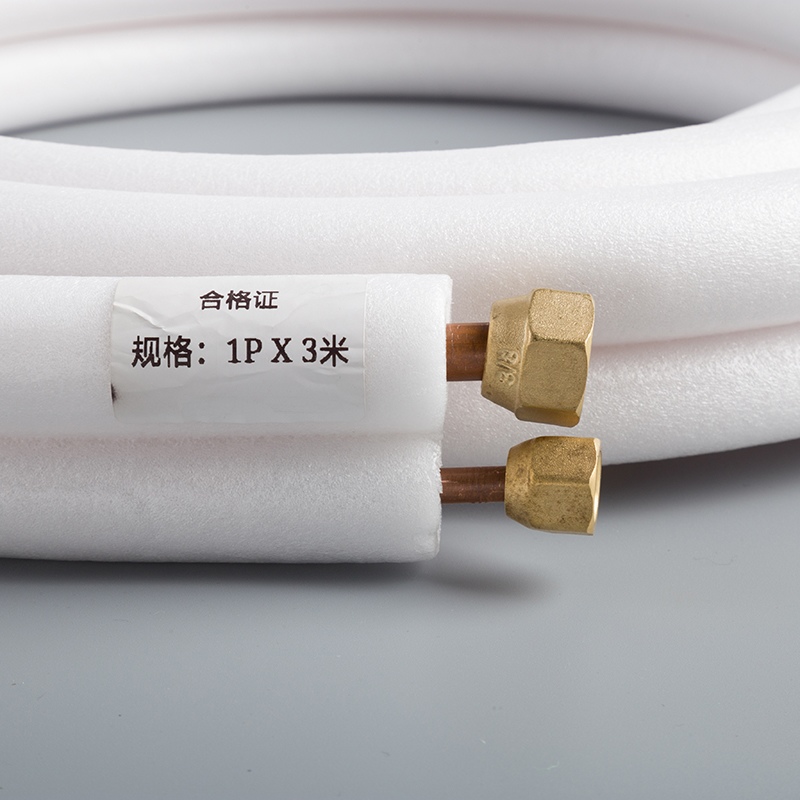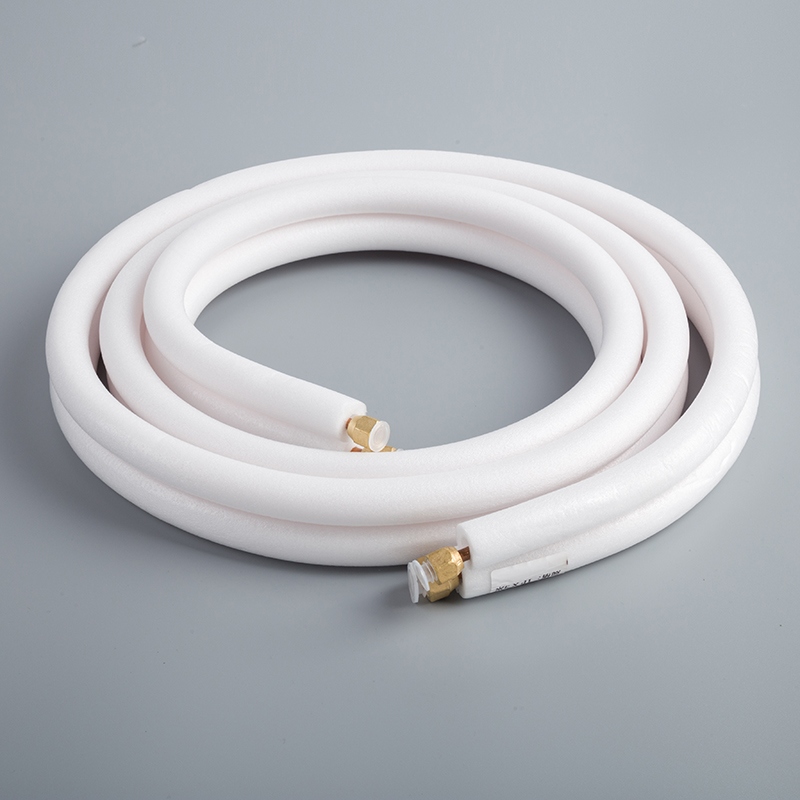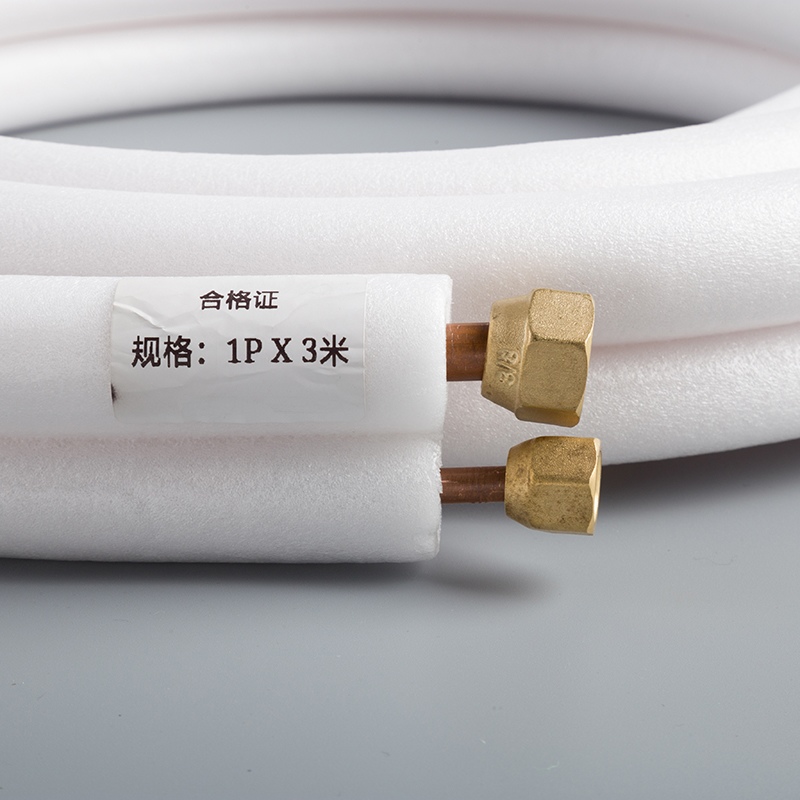HVAC Copper Fittings: Choose the Best for You

Selecting the appropriate HVAC copper fittings is vital for the performance of your system. These copper pipe fittings for air conditioning ensure minimal heat loss during air distribution, which saves energy and reduces costs. Their high thermal conductivity and corrosion resistance make them a preferred choice. You benefit from their durability and stability in both high and low temperatures, ensuring optimal performance year-round. By choosing high-quality copper pipe fittings, you enhance the efficiency and longevity of your HVAC system. This decision impacts not only the system's functionality but also its operational costs, making it essential for any HVAC setup.
Types of Copper Fittings

Understanding the different types of HVAC copper fittings is crucial for optimizing your system's performance. These fittings connect, reroute, or regulate the flow of refrigerant or coolant through copper pipes. Their high thermal conductivity and corrosion resistance make them a preferred choice in HVAC systems.
Couplings
Uses in HVAC systems
Couplings serve as connectors between two lengths of copper pipe. They are essential when you need to extend the length of a pipe or repair a damaged section. In HVAC systems, couplings ensure a seamless connection, maintaining the integrity of the refrigerant flow.
Benefits and considerations
Couplings offer several benefits. They provide a secure and leak-proof connection, which is vital for system efficiency. When selecting couplings, consider the compatibility with your existing pipes and the specific requirements of your HVAC system. High-quality copper pipe fittings ensure durability and reliability, reducing maintenance needs.
Elbows
Applications in HVAC systems
Elbows are used to change the direction of the copper piping. They are particularly useful in navigating around obstacles or fitting pipes into tight spaces. In HVAC systems, elbows help in directing the refrigerant flow efficiently, ensuring optimal system performance.
Advantages and limitations
Elbows offer flexibility in pipe installation, allowing for precise routing. However, each elbow introduces a slight resistance to the flow, which can affect system efficiency. It's important to balance the number of elbows used with the overall design of the system to maintain efficiency.
Tees
Functionality in HVAC systems
Tees are fittings that allow you to split or combine the flow of refrigerant. They are used when you need to branch off a main line to supply multiple areas or components within the HVAC system. This functionality is crucial for distributing refrigerant evenly throughout the system.
Key features
Tees provide versatility in system design, enabling efficient distribution of refrigerant. They are compatible with various HVAC components, making them a versatile choice. When choosing tees, ensure they match the size and specifications of your copper pipes for air conditioning to maintain system integrity.
Reducers
Purpose in HVAC systems
Reducers play a crucial role in HVAC systems by connecting pipes of different diameters. They help in managing the flow of refrigerant or coolant through the system, ensuring that it moves efficiently from one section to another. By using reducers, you can maintain the desired pressure and flow rate, which is essential for the optimal performance of your HVAC system. These fittings are indispensable when you need to transition between different pipe sizes without compromising the system's integrity.
Selection criteria
When selecting reducers for your HVAC system, consider several factors to ensure compatibility and efficiency. First, check the material and quality of the reducer. High-quality copper pipe fittings offer durability and resistance to corrosion, making them a reliable choice. Next, ensure that the reducer matches the diameters of the pipes you are connecting. This compatibility is vital for preventing leaks and maintaining system efficiency. Lastly, consider the specific requirements of your HVAC setup, such as pressure ratings and temperature ranges, to choose the most suitable reducer.
Adapters
Role in HVAC systems
Adapters serve as versatile connectors in HVAC systems, allowing you to join pipes or components with different connection types. They facilitate the integration of various parts, ensuring a seamless and efficient flow of refrigerant or coolant. By using adapters, you can enhance the flexibility and adaptability of your HVAC system, accommodating changes or upgrades with ease.
Important factors to consider
When choosing adapters, prioritize compatibility with your existing system components. Ensure that the adapter's material matches the copper pipe for air conditioning to maintain consistency and reliability. Additionally, consider the adapter's design and connection type, as these will impact the ease of installation and overall system performance. Opt for adapters that offer a secure and leak-proof connection to prevent any potential issues.
Caps
Usage in HVAC systems
Caps are essential fittings used to seal the ends of copper pipes in HVAC systems. They prevent the escape of refrigerant or coolant, ensuring that the system operates efficiently and safely. Caps are particularly useful during maintenance or repairs when you need to temporarily close off a section of the system.
Pros and cons
Caps offer several advantages, including their simplicity and effectiveness in sealing pipe ends. They are easy to install and remove, making them a convenient choice for temporary closures. However, it's important to select caps that are compatible with your system's specifications to avoid leaks or pressure issues. While caps provide a straightforward solution, they may not be suitable for permanent closures, as they can wear out over time.
Valves
Importance in HVAC systems
Valves play a crucial role in your HVAC system. They control the flow of refrigerant or coolant, ensuring that your system operates efficiently and safely. By regulating the flow, valves help maintain the desired temperature and pressure levels within the system. This regulation is essential for preventing potential damage and ensuring optimal performance. HVAC copper fittings like valves offer high thermal conductivity and corrosion resistance, making them a reliable choice for long-term use. Their durability and compatibility with various refrigerants enhance the overall efficiency and reliability of your HVAC setup.
Types and their applications
Understanding the different types of valves and their applications can help you make informed decisions for your HVAC system:
Ball Valves: These valves provide a quick and reliable way to shut off the flow of refrigerant. You can use them in situations where you need to isolate a section of the system for maintenance or repairs. Their simple design ensures minimal pressure drop and easy operation.
Globe Valves: Ideal for regulating flow, globe valves allow you to adjust the flow rate precisely. They are commonly used in applications where you need to control the flow of refrigerant to maintain specific temperature settings.
Check Valves: These valves prevent backflow, ensuring that the refrigerant flows in the correct direction. They are essential for protecting your HVAC system from potential damage caused by reverse flow.
Solenoid Valves: Used for automatic control, solenoid valves open and close in response to electrical signals. They are often used in systems that require precise control over the flow of refrigerant, such as in automated HVAC setups.
By selecting the right type of valve for your HVAC system, you can enhance its performance and longevity. Consider the specific requirements of your system, such as pressure ratings and flow rates, when choosing valves. High-quality copper pipe fittings ensure that your valves provide a secure and leak-proof connection, contributing to the overall efficiency of your HVAC system.
Types of Copper Tubing
Understanding the types of copper tubing is essential for optimizing your HVAC system. Each type offers unique characteristics that suit different applications and installation scenarios.
Soft Copper
Characteristics and uses
Soft copper tubing is known for its flexibility, making it ideal for applications where bending and shaping are necessary. You can easily manipulate this tubing to fit around obstacles or into tight spaces without the need for additional fittings. This flexibility makes soft copper a popular choice for refrigerant lines in split-system air conditioners and heat pumps. Its ability to withstand both high and low temperatures ensures reliable performance across various HVAC applications.
Installation tips
When installing soft copper tubing, handle it with care to avoid kinks or damage. Use a tube bender to achieve smooth curves and prevent any restrictions in the flow of refrigerant. Ensure that the tubing is properly supported along its length to maintain its shape and prevent sagging. By following these installation tips, you can maximize the efficiency and longevity of your HVAC system.
Rigid Copper
Features and applications
Rigid copper tubing offers durability and stability, making it suitable for applications requiring a more robust connection. This type of tubing is commonly used for water lines and other installations where a strong, stable pipe is necessary. Its resistance to corrosion and high pressure makes it a reliable choice for HVAC systems that demand long-lasting performance.
Installation guidelines
When installing rigid copper tubing, precise measurements and cuts are crucial. Use a pipe cutter to ensure clean, straight edges for a secure fit. Soldering is often required to join sections of rigid copper tubing, so ensure that you have the necessary tools and skills for this process. Properly support the tubing to prevent movement and potential leaks. By adhering to these guidelines, you can ensure a secure and efficient installation.
Types of Copper Pipe Fittings

Understanding the various types of copper pipe fittings is crucial for optimizing your HVAC system. Each type offers unique advantages and is suited for specific installation scenarios.
Compression Fittings
Advantages in HVAC systems
Compression fittings provide a reliable and leak-proof connection, making them ideal for HVAC systems. You can easily install them without the need for soldering, which simplifies the process and reduces installation time. These fittings are particularly beneficial in situations where you need to make quick repairs or adjustments. Their design allows for easy disassembly, enabling you to perform maintenance or replacements without hassle. By using compression fittings, you ensure a secure connection that maintains the integrity of the refrigerant flow.
Installation scenarios
You will find compression fittings useful in various installation scenarios. They are perfect for connecting pipes in tight spaces where soldering might be challenging. Additionally, they are suitable for temporary installations or when you anticipate future modifications. When installing compression fittings, ensure that the pipe ends are clean and free from debris to achieve a tight seal. Regular inspection of these fittings is essential to identify potential issues before they escalate, as emphasized by HVAC professionals.
End Feed Fittings
Benefits and uses
End feed fittings offer a cost-effective solution for connecting copper pipes in HVAC systems. They require soldering, which provides a strong and permanent connection. These fittings are ideal for applications where you need a durable and long-lasting joint. By using end feed fittings, you benefit from their simplicity and effectiveness in maintaining a secure connection. They are commonly used in both residential and commercial HVAC installations.
Installation process
The installation process for end feed fittings involves soldering, which requires some skill and the right tools. First, clean the pipe ends and the fitting to ensure a good bond. Apply flux to the surfaces to facilitate the soldering process. Heat the joint evenly and apply solder until it flows into the joint, creating a strong seal. Allow the joint to cool naturally before testing for leaks. Proper installation ensures that your HVAC system operates efficiently and safely.
Solder Ring Fittings
Key features and applications
Solder ring fittings, also known as Yorkshire fittings, come with a pre-installed ring of solder inside the fitting. This feature simplifies the installation process, as you only need to heat the joint to melt the solder and create a secure connection. These fittings are ideal for HVAC systems where you need a reliable and consistent joint. They are commonly used in applications where precision and ease of installation are priorities.
Installation considerations
When installing solder ring fittings, ensure that the pipe ends are clean and free from oxidation. Heat the joint evenly to melt the solder ring and form a strong bond. Avoid overheating, as this can cause the solder to run out of the joint. After installation, inspect the joint for any signs of leaks or weaknesses. Regular maintenance and inspection of these fittings help maintain the efficiency and longevity of your HVAC system.
Push Fit Fittings
Push fit fittings offer a user-friendly solution for connecting copper pipes in HVAC systems. You can easily install these fittings without the need for specialized tools or soldering, making them an excellent choice for quick and efficient installations. The design of push fit fittings allows you to simply push the pipe into the fitting, creating a secure and leak-proof connection. This ease of use significantly reduces installation time and effort, making it ideal for both professionals and DIY enthusiasts.
Ease of use and benefits
The primary benefit of push fit fittings lies in their simplicity. You don't need to worry about complex installation processes or potential errors associated with soldering. This feature makes them particularly advantageous in situations where time is of the essence. Additionally, push fit fittings provide a reliable seal that minimizes the risk of leaks, ensuring the efficiency and longevity of your HVAC system. Their versatility allows you to use them in various applications, accommodating different pipe sizes and configurations.
Suitable applications
Push fit fittings are suitable for a wide range of HVAC applications. You can use them in both residential and commercial settings, where quick and reliable connections are necessary. They are especially useful in tight spaces where traditional fittings might be challenging to install. Whether you're working on new installations or making repairs, push fit fittings offer a convenient and effective solution. Regular inspection of these fittings, as advised by HVAC professionals, ensures that they maintain their integrity and performance over time.
Press Fittings
Press fittings provide an efficient and modern approach to connecting copper pipes in HVAC systems. These fittings use a pressing tool to create a secure and permanent connection, eliminating the need for soldering. This method not only speeds up the installation process but also enhances the overall safety and reliability of the system.
Efficiency and advantages
The efficiency of press fittings stems from their ability to create strong connections quickly. You can achieve a consistent and reliable seal with minimal effort, reducing the likelihood of leaks and system failures. Press fittings are designed to withstand high pressure, making them suitable for demanding HVAC applications. Their durability and resistance to corrosion ensure that your system remains efficient and operational for years to come. By choosing high-quality copper pipe fittings, you enhance the performance and longevity of your HVAC setup.
Installation techniques
Installing press fittings involves using a specialized pressing tool to compress the fitting onto the pipe. This process creates a watertight seal that ensures the integrity of the connection. Before installation, ensure that the pipe ends are clean and free from debris. Proper alignment of the fitting and pipe is crucial for achieving a secure connection. Once aligned, use the pressing tool to complete the installation. This technique not only simplifies the process but also minimizes the risk of errors, making it a preferred choice for many HVAC professionals.
Choosing the Right Type of Copper Pipe
Selecting the right type of copper pipe is crucial for the efficiency and longevity of your HVAC system. Each type of copper pipe offers unique characteristics that suit different applications. Understanding these differences helps you make informed decisions.
Type L Copper Pipe
Characteristics and suitability
Type L copper pipe is known for its medium wall thickness, making it a versatile choice for various HVAC applications. It provides a balance between strength and flexibility, which is essential for both residential and commercial systems. This type of pipe is suitable for indoor plumbing, heating, and cooling systems due to its ability to handle moderate pressure levels. Its durability ensures long-lasting performance, even under challenging conditions.
Selection tips
When choosing Type L copper pipe, consider the specific requirements of your HVAC system. Ensure that the pipe's diameter matches the system's specifications to maintain optimal flow and pressure. Look for pipes that meet ASTM International standards, as these guarantee quality and reliability. Additionally, consider the installation environment. Type L copper pipe is ideal for areas where moderate pressure and temperature variations occur. By selecting the right size and quality, you enhance the efficiency and safety of your HVAC setup.
Type K Copper Pipe
Features and applications
Type K copper pipe boasts the thickest walls among copper pipes, providing exceptional strength and durability. This makes it suitable for high-pressure applications and underground installations. Its robust construction ensures resistance to corrosion and mechanical damage, making it a reliable choice for demanding HVAC systems. Type K copper pipe is often used in commercial and industrial settings where long-term performance is critical.
Decision-making factors
When deciding on Type K copper pipe, evaluate the pressure and environmental conditions of your HVAC system. This type of pipe is ideal for systems that require high-pressure handling and are exposed to harsh conditions. Ensure that the pipe's dimensions align with your system's needs to prevent any flow restrictions. Consider the installation process, as Type K copper pipe may require specialized tools and skills due to its thickness. By choosing the appropriate pipe type, you ensure the longevity and reliability of your HVAC system.
Choosing the right HVAC copper fittings is crucial for your system's performance and longevity. These fittings, like compression, end feed, and solder ring, each offer unique benefits. Compression fittings provide a secure connection with ease, while end feed fittings ensure a snug fit. Solder ring fittings simplify the installation process. By understanding these options, you can make informed decisions that enhance your HVAC system's efficiency. Always prioritize high-quality copper pipe fittings to prevent leaks and ensure durability. Your choice impacts not only the system's functionality but also its operational costs.
See Also
Exploring Top Copper Pipe Fittings for Plumbing Needs
Benefits of Selecting Copper Tubing for AC Systems
Become a Pro with Copper Pipe Fittings: DIY Handbook


